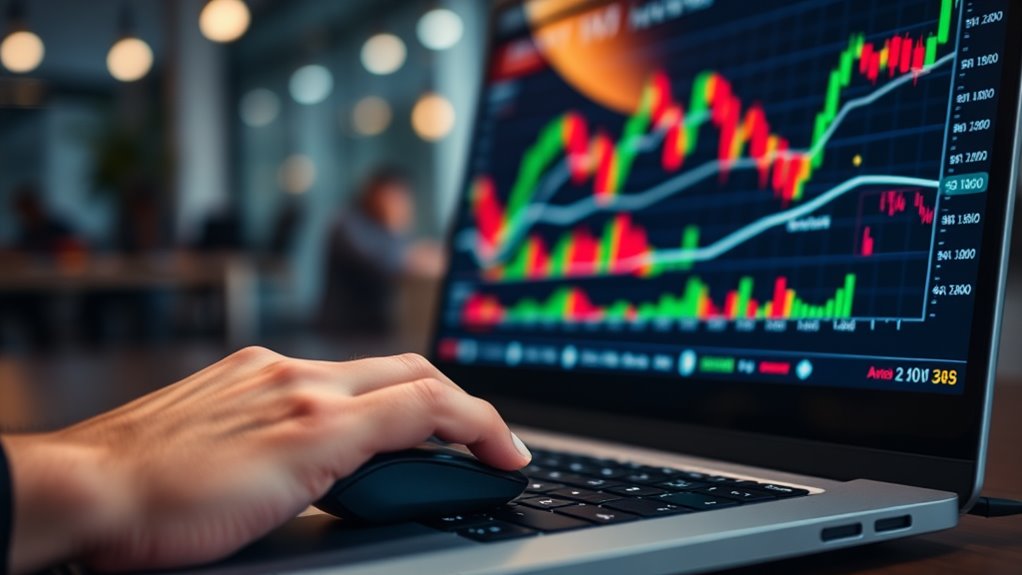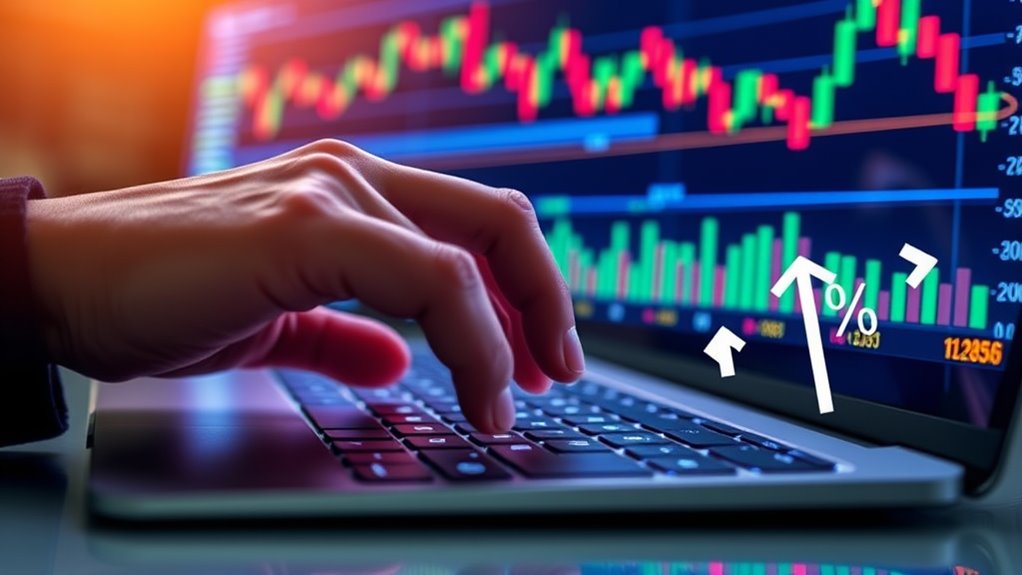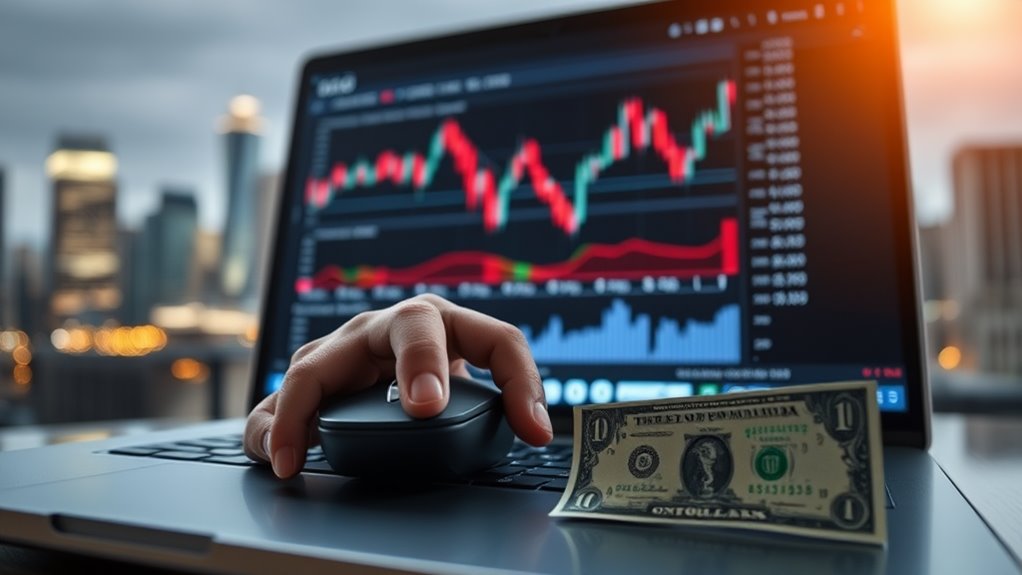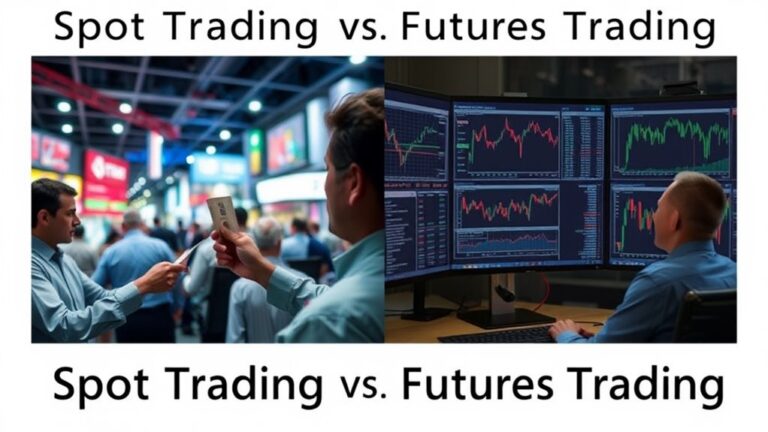
Slippage in Crypto Trading: What Is It and How Does It Impact?
Slippage in crypto trading occurs when orders execute at different prices than expected due to market volatility and liquidity issues. It manifests as either positive (better price) or negative (worse price) execution differences. This price gap is more prevalent in cryptocurrency markets than traditional ones and can greatly impact profitability, especially for large trades. Traders can minimize slippage by using limit orders, trading during calm periods, and selecting high-liquidity exchanges. Understanding slippage mechanics helps traders develop more effective strategies.
Key Takeaways
- Slippage is the difference between expected and actual execution prices in crypto trades, occurring due to market volatility and liquidity constraints.
- Negative slippage results in worse prices than anticipated, while positive slippage provides better execution prices than expected.
- Large order sizes significantly increase slippage risk by exceeding available liquidity, especially on decentralized exchanges using AMM mechanisms.
- Slippage can be minimized by using limit orders, trading during low-volatility periods, and breaking large trades into smaller segments.
- Institutional traders experience greater monetary impact from slippage, potentially accumulating into significant losses over time and affecting ROI.
Understanding the Basics of Slippage in Cryptocurrency Markets

The price gap between expectation and reality defines slippage in cryptocurrency trading. This phenomenon occurs when a trade executes at a different price than what was intended due to market movement between order placement and execution.
Slippage manifests in two forms: positive slippage, where trades execute at better prices than expected, and negative slippage, which results in less favorable prices. The highly volatile nature of cryptocurrency markets makes slippage more common than in traditional financial systems.
Several factors contribute to slippage, including market volatility, liquidity constraints, and the global fragmentation of crypto markets. Understanding order book depth is crucial for traders, as it indicates the market’s ability to manage trades without significant price swings.
Both buy and sell orders are susceptible to slippage, affecting overall trading costs and profitability. The impact varies between centralized exchanges, where order book depth matters, and decentralized platforms, where liquidity pool mechanics play a vital role.
Key Factors That Influence Slippage Levels When Trading Crypto

Having established what slippage means in cryptocurrency trading, we must examine specific factors that determine its severity.
Market volatility stands as a primary contributor, with rapid price movements causing execution disparities. Liquidity plays an equally important role, as assets with fewer active traders typically experience greater slippage.
Market volatility and liquidity constraints remain the twin forces driving execution slippage in cryptocurrency markets.
Order size greatly impacts execution price, particularly when large trades exceed available liquidity at desired price points. Technical factors, including trading speed and exchange infrastructure, can create delays that exacerbate price differences.
The type of order placed also matters—market orders accept available prices immediately, while limit orders establish price boundaries to control potential slippage.
Additionally, the trading environment itself matters, with decentralized exchanges (DEXs) typically experiencing higher slippage than centralized platforms due to liquidity differences. This is largely because centralized exchanges generally offer higher liquidity, which helps minimize slippage during trades.
Centralized vs. Decentralized Exchanges: Slippage Comparison

Centralized exchanges typically maintain higher liquidity pools than their decentralized counterparts, resulting in less frequent and less severe slippage during trading.
In contrast, decentralized exchanges utilize Automated Market Maker (AMM) mechanisms that rely on mathematical formulas and liquidity pools to determine asset prices.
This fundamental difference in market structure means that large trades on DEXs often face greater slippage risks as they can markedly disrupt the balance of these liquidity pools, especially for less popular trading pairs. Additionally, liquidity pools on DEXs can lead to increased price volatility during significant market movements.
CEX Liquidity Advantage
When evaluating exchanges for cryptocurrency trading, liquidity stands as the paramount advantage that centralized exchanges (CEXs) hold over their decentralized counterparts. This abundance of liquidity enables traders to execute substantial orders with minimal price impact, considerably reducing the risk of slippage during transactions.
The high liquidity environment of CEXs allows for quick execution of trades without the price fluctuations commonly experienced on DEXs. Large-volume traders particularly benefit from this stability, as their transactions can be completed almost instantly without waiting for matching orders or sufficient pool depth.
This efficiency translates to more predictable trading outcomes and fewer instances of negative slippage, where execution prices are worse than expected. For traders prioritizing consistent execution prices and immediate market access, CEXs provide a compelling solution to the slippage challenges inherent in cryptocurrency trading. Additionally, security tips such as enabling two-factor authentication can further enhance the trading experience on these exchanges.
DEX AMM Mechanisms
Unlike traditional order-book exchanges, decentralized exchanges (DEXs) employ Automated Market Maker (AMM) mechanisms that fundamentally change how cryptocurrency trading operates and directly impact slippage.
These AMMs use smart contracts to create liquidity pools where traders interact with algorithms rather than other traders.
The most common model, Constant Product Market Maker (CPMM), maintains a mathematical relationship between tokens in a pool. When users trade, they alter this balance, causing price adjustments that often result in slippage.
Larger trades relative to pool size create greater imbalances and higher slippage.
While DEXs offer enhanced security and transparency through their decentralized structure, their AMM design introduces predictable price impacts during trades.
This inherent characteristic makes slippage more prevalent in DEXs compared to centralized exchanges, especially in pools with limited liquidity. Additionally, the integration of Decentralized Finance (DeFi) innovations can further impact slippage dynamics as they change liquidity availability and trading strategies.
How to Calculate and Measure Slippage on Your Trades

Every successful crypto trader needs to understand how slippage affects their bottom line. Calculating slippage involves determining the difference between the expected price and the actual execution price of a trade. This difference is typically expressed as a percentage using the formula: (Slippage/Expected Price) × 100.
Traders should track both negative slippage (when execution price is worse than expected) and positive slippage (when execution price is better than expected).
To measure slippage effectively, consider analyzing historical patterns through visual tools like heatmaps, which reveal higher slippage periods during weekdays. Statistical correlation between slippage and market volatility provides valuable insights for strategic trading decisions.
Time-based analysis also helps identify when slippage is likely to occur, allowing traders to adjust their strategies accordingly.
Practical Strategies to Minimize Slippage Losses

Understanding slippage calculation provides traders with valuable insights, but actively implementing strategies to reduce its impact brings tangible improvements to trading outcomes.
Traders can minimize slippage by selecting high-liquidity exchanges and trading pairs like BTC/USDT, which offer more stable pricing environments.
Using limit orders instead of market orders prevents unfavorable price deviations during execution. Breaking large trades into smaller segments helps reduce market impact, while trading during calm market conditions—typically early mornings or non-peak hours—can notably lower slippage risks.
For DeFi traders, platforms with automated market makers like Uniswap often provide better slippage control. Setting appropriate slippage tolerance levels guarantees trades execute without excessive price movement.
Advanced traders can leverage algorithmic tools and trading bots to optimize execution timing and route selection. Additionally, choosing exchanges that prioritize security features can protect your funds and enhance overall trading confidence.
The Financial Implications of Slippage on Investment Returns

While often overlooked by novice traders, slippage represents a significant factor that can substantially erode cryptocurrency investment returns over time. Even small percentages of slippage accumulate into considerable losses, particularly for strategies with narrow profit margins or high-frequency trading approaches.
The financial impact extends beyond immediate transaction costs. Slippage diminishes ROI by increasing expenses and reducing profit potential, with effects magnified during volatile market conditions. For instance, understanding the difference between limit and market orders can help traders mitigate the risk of slippage.
For retail investors, minor slippage may seem negligible, but institutional traders face substantial monetary consequences when small percentage changes affect large positions.
Risk management becomes more challenging as unexpected price movements complicate position calculations. In leveraged trading scenarios, excessive slippage can trigger margin calls or amplify losses.
Conversely, high-liquidity markets typically experience reduced slippage, regardless of overall market volatility.
Market Volatility and Liquidity: Their Relationship With Slippage

Cryptocurrency markets experience a potent combination of volatility and liquidity challenges that directly influence slippage rates.
Price swings in volatile crypto markets can rapidly change asset values between order placement and execution, resulting in trades executing at unexpected prices.
The depth of market liquidity further compounds this effect, as thinner markets with fewer participants lack the order book depth needed to absorb large trades without significant price impact.
Market Volatility and Liquidity: Their Relationship With Slippage
As cryptocurrencies surge and plummet in value, traders face a critical challenge known as slippage, which emerges from the twin forces of market volatility and liquidity.
These factors interact in complex ways, creating a feedback loop that impacts trade execution prices.
Research indicates a strong negative relationship between volatility and liquidity—as volatility increases, liquidity often decreases, magnifying slippage risks.
High volatility causes rapid price fluctuations, making it difficult to execute trades at expected prices, while low liquidity means fewer market participants to fulfill orders at desired levels.
This relationship exhibits predictable patterns, including U-shaped intraday fluctuations in both metrics.
Traders who understand this nexus can better prepare by timing their trades during higher liquidity periods and implementing strategies like limit orders to mitigate slippage risks. Additionally, incorporating technical and fundamental analysis can enhance decision-making processes, further reducing the likelihood of experiencing slippage.
Price Swings Amplify Slippage
When market volatility increases, the likelihood and severity of slippage in cryptocurrency trading escalate considerably. Rapid price fluctuations occur within seconds, making it difficult for trades to execute at intended prices. High-frequency trading algorithms further amplify this effect by processing millions of trades simultaneously. Regulatory clarity is expected to improve in the coming years, which may help stabilize the cryptocurrency market and reduce instances of slippage.
Market orders are particularly vulnerable during price swings, while low liquidity exacerbates the issue by allowing large trades to considerably impact prices.
| Slippage Factor | Impact Level | Mitigation Strategy |
|---|---|---|
| Price Volatility | High | Use limit orders |
| Market Liquidity | Medium-High | Trade during stable periods |
| Order Size | Medium | Break into smaller orders |
| Order Type | Variable | Select appropriate order types |
Traders can minimize negative slippage effects by monitoring market conditions, adjusting slippage tolerance settings, and implementing thoughtful timing strategies for their transactions.
Liquidity Depth Matters
The depth of liquidity in cryptocurrency markets directly influences the severity of slippage traders experience during transactions. Assets with deeper order books demonstrate greater resistance to price fluctuations during trades, as sufficient buy and sell orders exist at various price levels.
Markets with robust liquidity feature more market participants, creating a stabilizing effect that minimizes price gaps between orders. When trading venues have adequate depth, even larger transactions can execute without considerably impacting market prices.
Conversely, thin liquidity results in wider spreads between bid and ask prices, increasing the likelihood of orders executing at unfavorable rates.
For traders, choosing exchanges and assets with higher trading volumes becomes a strategic consideration for managing slippage risk. Order book depth serves as a critical indicator of how efficiently trades can be executed without price disruption. Furthermore, new regulations affecting crypto exchanges may also introduce changes in liquidity dynamics, which could impact slippage patterns.
Advanced Order Types and Their Effect on Reducing Slippage

Traders seeking to minimize slippage in cryptocurrency markets frequently turn to advanced order types as essential tools for price control. These specialized instructions help guarantee trades execute at or near intended prices, even in volatile conditions.
| Order Type | Slippage Protection | Best Use Case |
|---|---|---|
| Limit Orders | High | Precise price entry/exit |
| Stop Orders | Medium | Downside protection |
| Stop-Limit | High | Controlled exits |
| Conditional | High | Complex strategies |
| OCO (One-Cancels-Other) | Medium-High | Two-scenario planning |
While limit orders provide precise price control by only executing at specified prices, stop orders convert to market orders when triggered, potentially experiencing slippage during volatile periods. Stop-limit orders offer more control by combining these features. Conditional orders enhance flexibility by responding to specific market criteria, allowing traders to implement sophisticated risk management strategies without constant monitoring.
Frequently Asked Questions
Can Slippage Be Systematically Exploited for Arbitrage Opportunities?
Slippage can be systematically exploited for arbitrage opportunities through sophisticated trading algorithms that identify price discrepancies across markets and execute rapid transactions, though success requires advanced technology and careful risk management strategies.
How Does Slippage Differ Across Various Cryptocurrency Trading Pairs?
BTC/USD experiences 0.3% average slippage compared to 2-5% in altcoin pairs. Slippage varies across cryptocurrency pairs based on market volatility, liquidity depth, order size, trading platform infrastructure, and token-specific factors.
Do Hardware Wallets or Trading Interfaces Affect Slippage Rates?
Hardware wallets don’t directly affect slippage as they only store cryptocurrencies. Trading interfaces, however, can impact slippage through execution speed, liquidity access, and order type options offered to traders.
Is Slippage Tax-Deductible as a Trading Expense?
Slippage may be tax-deductible as a trading expense when properly documented as part of ordinary and necessary business costs. However, specific treatment varies by jurisdiction, and consultation with a tax professional is recommended.
How Do Flash Crashes Specifically Impact Slippage Mechanics?
Flash crashes exacerbate slippage by depleting order book liquidity, widening bid-ask spreads, and triggering cascading liquidations. These factors collectively force trades to execute at increasingly unfavorable prices as the market rapidly deteriorates.
Conclusion
Slippage remains an inevitable aspect of cryptocurrency trading that demands strategic management and proper risk assessment. Through understanding market dynamics, selecting appropriate exchanges, and utilizing advanced order types, traders can greatly reduce its impact on their portfolios. Have you considered how small percentage differences from slippage might compound over hundreds of trades? By implementing the outlined strategies, investors can protect their returns and trade with greater confidence in volatile markets.












